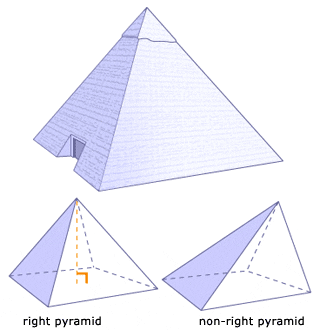- Polyhedron
- Prisms
- Pyramids
3D Shapes
Pyramids
A pyramid is a polyhedron for which the base is a polygon and all lateral faces are triangles. In this lesson, we'll only concern ourselves with pyramids whose lateral faces are congruent — that is, they're the same size and shape.
Technically, when the lateral faces are congruent triangles, the shape is known as a right pyramid, indicating that the apex — the vertex at which the lateral faces meet — is directly above the center of the base. In this lesson, when we use the term pyramid, we mean a right pyramid. But there are other types of pyramids, too.
A pyramid is typically described by the shape of its base. For instance, a triangular pyramid has a base that is a triangle, and a hexagonal pyramid has a base that is a hexagon.

Explore & Play with Pyramids
Use the animation below to explore the properties of four pyramids. Follow the instructions below to change the direction and speed of the prism's rotation and to highlight the numbers of faces (F), vertices (V), and edges (E) for each prism.